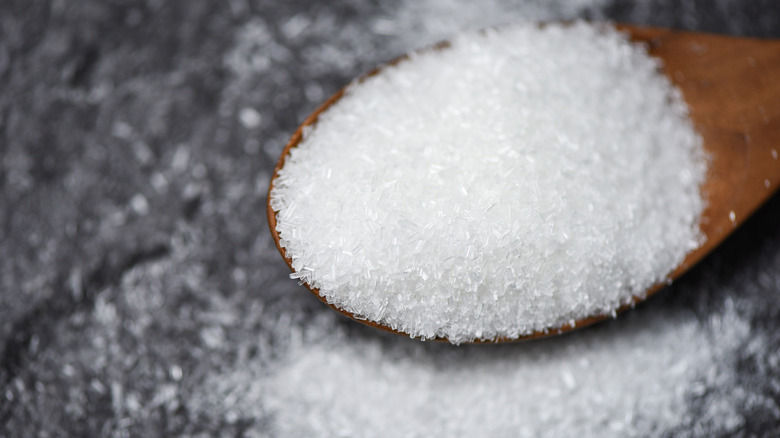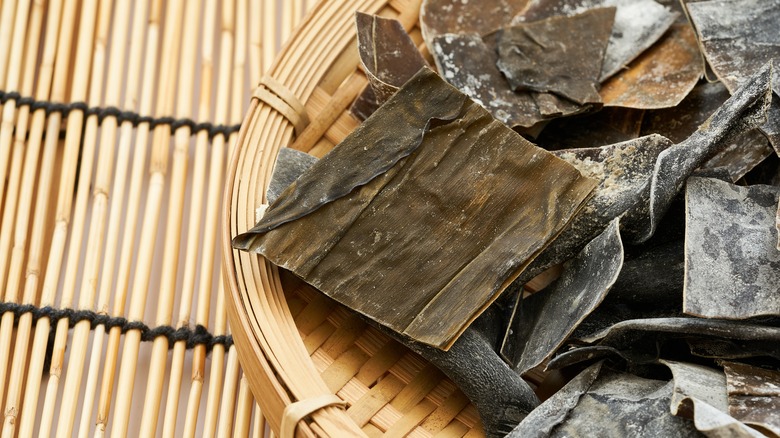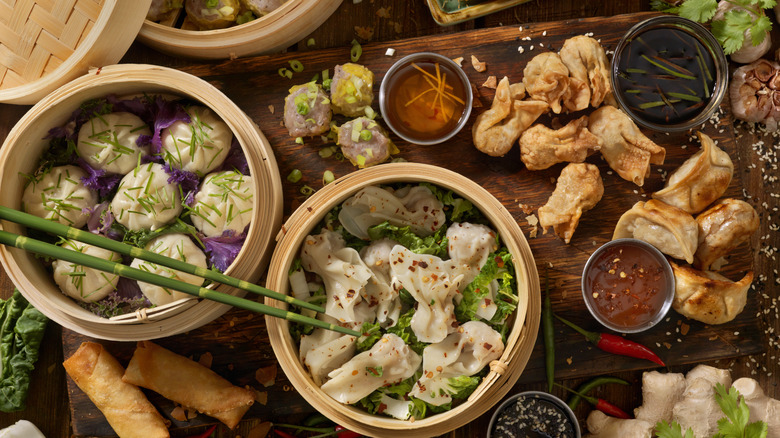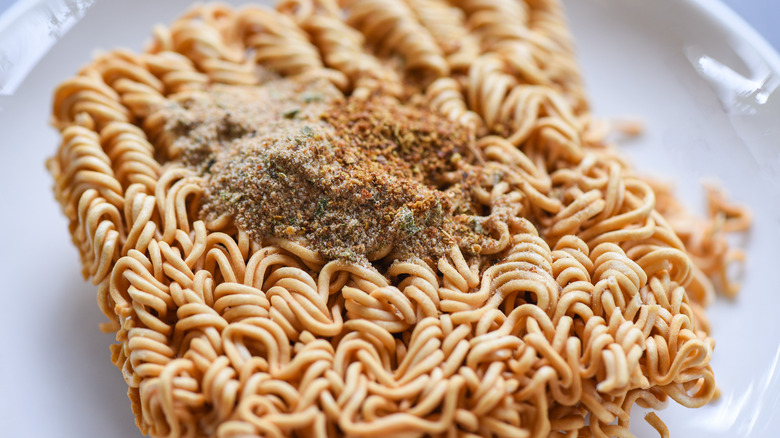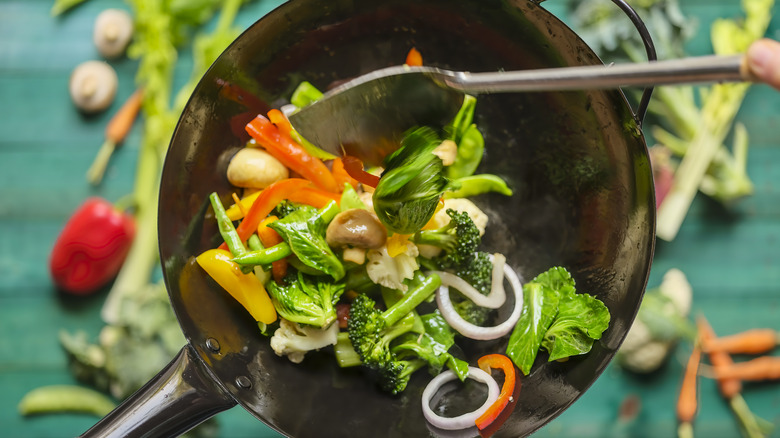The Biggest Myth About MSG Is Rooted In Racism
For decades, a culinary stigma has lingered over Monosodium Glutamate, commonly known as MSG. A substance naturally derived from seaweed, MSG is a salt that unlocks a taste dimension known as umami. Despite plenty of sound scientific evidence that proves otherwise, it is a seasoning that's often been unjustly blamed for headaches and various ailments.
Beyond the fact that this myth is largely based on anecdotal evidence, the perception that MSG is somehow detrimental to your health has cultivated a biased and racist view against Chinese food, devaluing its contribution to the global food community and robbing Chinese cuisine of the recognition and respect it truly deserves. The negative stigma can be felt even today, although public perception is beginning to turn around thanks to a campaign of entertainment and education. When used properly, MSG has the miraculous ability to enhance the flavor of many types of dishes, giving your food a flavor boost that is unlike anything else.
What is MSG?
Monosodium glutamate, commonly known by its initials, is a natural salt. If you have ever seen a package of dried kombu or wakame seaweed, the white powdery substance dusting its surface is MSG in its natural form. It is also present in plenty of vegetables, most notably tomatoes, walnuts, and mushrooms, the same ingredients used to produce ketchup in the condiment's early history.
The substance was discovered in 1907 by Kikunae Ikeda — a professor at the Tokyo Imperial University — who was on a quest to understand umami, a flavor that is described as "savory" or "meatiness." Although umami is now a common word, it was unknown to the Western world at the time. Production of the salt became industrialized by 1909 under the label Aji-no-moto.
Although almost solely associated with Chinese food, you can actually find MSG in many kinds of common foods like Doritos, Pringles, and fried chicken. It is also present in seasoning packets of instant ramen and is naturally present in some cheeses like Parmesan.
MSG, racism, and Chinese food
So how does a substance that was discovered and industrialized in Japan and used in American snacks and fast food get a negative association with Chinese food?
The story apparently started with a doctor who wrote a letter in the 1960s to the New England Journal of Medicine, a prestigious medical journal, describing a series of symptoms he suffered after consuming Chinese food. As discussions spread, these vaguely defined syndromes (bloatedness, headaches, etc.) became known as "Chinese Restaurant Syndrome."
Although the responses to the letter were dismissive, mainstream journalists at the time took the letter and ran with it, spreading the rumor and defining Chinese food as unhealthy and even poisonous. Meanwhile, actual scientific studies have shown again and again that consuming MSG has no ill effects on the human body (via FDA).
The pervasiveness of this myth imprinted a negative view of Chinese food throughout Western culture, banishing Chinese cuisine to the realm of fast food and pigeonholing it as something that is cheap and bad for you. The negative reputation led to the idea that Chinese cuisine is not as prestigious as other national cuisines such as Italian and French, resulting in a dearth of upscale Chinese restaurants in the Western world.
Dispelling the myth: MSG Revival
In recent years, as the public has become more aware of the science of umami, the origins of MSG, and the associated stigma based on outdated and racist views, the seasoning has gained renewed interest as a seasoning and as a condiment. Chefs in some of the highest-rated restaurants in the world, including Momofuku's David Chang, have been passionate about spreading the gospel of MSG. A successful campaign was also launched to convince Merriam-Webster to alter the definition of "Chinese Restaurant Syndrome" to reflect the underlying bias of the term. Meanwhile, on YouTube, food personalities such as Nigel Ng (of Uncle Roger fame) and Joshua Weissman have passionately advocated for the use of MSG to their millions of followers.
On the other hand, those who continued to rely on the outdated stigma of MSG have faced public criticism. When a white restaurateur opened a Chinese restaurant in New York City in 2019 touting their offerings as "cleaner" and less "icky" than traditional Chinese food, she was roundly criticized for relying on the racist stereotype that Chinese food offered by Chinese people is somehow "dirty." Accused of cultural appropriation, the restaurant closed shortly after. Today, some Chinese restaurants even offer MSG in a shaker as a condiment for the diners, in case their food is not as umami-filled as they would like.
How to use MSG at home
Readily available in most Asian markets, MSG can be used at home as a seasoning for your home cooking. It acts as a finishing touch and adds a savory flavor boost to a wide variety of dishes, taking many of them to the next level.
For example, you can add a small amount of MSG to salad dressings, giving them a flavor that regular salt and pepper do not offer. You can also add MSG when making soups such as an Asian-influenced chicken noodle soup, which is simmered with crushed stalks of lemongrass and thinly sliced ginger. A sprinkle of MSG near the end of the cooking process enhances the meatiness of the chicken broth and makes the soup taste and feel more substantial. Of course, MSG is also a great finishing condiment for stir-fried dishes, such as the classic sliced beef and broccoli.
In fact, you might have a condiment that is heavy on MSG in your own pantry without realizing it, since many seasoning mixes contain MSG. For example, instant dashi powder, which forms a base of everything from miso soup to Japanese chicken and egg rice, has substantial amounts of MSG in it. Another example is Chinese chicken powder, a favorite of Chinese home cooks, which is an MSG-packed chicken-flavored seasoning that enhances everything from congee to stir-fries.

